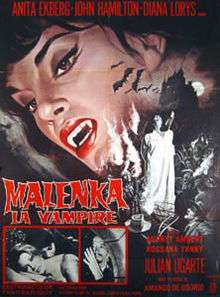Malenka
| Malenka, the Vampire's Niece | |
|---|---|
 French release poster | |
| Directed by | Amando de Ossorio |
| Written by | Amando de Ossorio |
| Starring | Anita Ekberg |
| Music by | Carlo Savina |
| Cinematography | Fulvio Testi |
| Edited by | Antonio Gimeno |
Production company |
Cobra Films, Felix Cinematografica, Tritón P.C. |
Release date |
|
Running time | 88 minutes |
| Country | Spain, Italy |
| Language | Spanish English Italian |
Malenka, the Vampire's Niece (also referred to as Malenka la vampire, Malenka: la nipote del vampiro, Malenka: la sobrina del vampiro, The Vampire Girl and Fangs of the Living Dead) is a 1969 Spanish-Italian horror film that was written and directed by Spanish director Amando de Ossorio; it was his first horror film.[1][2] One of the first vampire films from Spain,[3] it was inspired by similarly themed Italian and British vampire films that were being released during the same time period, such as Dance of the Vampires.[4] It has been credited as being "the 1969 picture that hammered the final nail into the cinematic coffin of the bomb-shelter-era bombshell Anita Ekberg",[5] as well as being "one of the most original gothic examples of Spanish horror".[6]
Plot
The beautiful and virginal Sylvia (Anita Ekberg) is delighted to discover that she's inherited not only the noble title of countess, but has also inherited a castle located in the country. She excitedly calls her fiance, Dr. Piero Luciani (Gianni Medici), to tell him that she's going to travel to view the castle. Once there, she stops at a local inn for a drink, where she announces her destination and relation to the castle's inhabitants; this horrifies the townspeople. Unswayed by their reactions, Sylvia arrives at the castle and meets her uncle, Count Walbrooke (Julián Ugarte), and beds down for the night. She is later awakened by the maidservant Blinka (Adriana Ambesi), who warns her that Walbrooke is a century-old vampire that means her harm. Blinka's attempts to draw Sylvia out of bed and out of the castle are interrupted by Walbrooke, who takes her into another room and whips her. Sylvia pleads with him to stop, only for Walbrooke to reveal that Blinka herself is also a vampire.
The next morning, Sylvia attempts to leave but is persuaded to stay after Walbrooke tells her about her aunt Malenka, who was burned at the stake for being a witch. He convinces Sylvia that the family is cursed, and that because of her strong resemblance to Malenka, paired with her ties to the family, Sylvia is also cursed. Furthermore, Sylvia must remain at the castle and stay unmarried, otherwise the curse will worsen and affect those around her. As a result, Sylvia breaks off her engagement with Piero, who decides to travel to the castle out of concern for Sylvia. When he arrives at the same inn that Sylvia visited earlier in the film, Piero is filled in on the events by Brugard (Juanita Ramírez), one of the inn's barmaids. He then travels to the castle, intending to stop Walbrooke from turning Sylvia into a vampire. The uncle's "vampire ploy" turns out to be a hoax he's using to drive his niece crazy.
Cast
- Anita Ekberg as Malenka/Sylvia Morel
- Gianni Medici as Dr. Piero Luciani (as John Hamilton)
- Diana Lorys as Bertha Zemis
- Rosanna Yanni as Freya Zemis
- César Benet as Max (as Guy Roberts)
- Carlos Casaravilla as Dr. Horbinger
- Fernando Bilbao as Vladis the Coachman
- Paul Muller as Dr. Albert
- Adriana Santucci as The Count's Maid
- Aurelia Treviño as Village Woman
- Juanita Ramírez as Brugard the Barmaid
- Adriana Ambesi as Blinka (as Audrey Ambert)
- Julián Ugarte as Uncle/Count Walbrooke
- Keith Kendal as Man
Production
Julián Ugarte played the vampire uncle, Count Walbrooke, fresh from his appearance as the vampire in Paul Naschy's classic La marca del hombre lobo (1968). Boris Karloff was initially approached to star in the film, but he eventually turned down the role following contractual wrangles, and died before the film was completed.[7]
The musical score by Carlo Savina (later the music director of films such as The Godfather and Amarcord) was reused in the 1971 low-budget horror film La notte dei dannati.[7]
An alternate supernatural ending was added to the English-language version of the film, in which the uncle disintegrates into a skeleton at the end, apparently indicating that he really was a vampire and contradicting the rest of the film.[7]
Release
The movie had its world premiere on 23 July 1969 in Italy and was released in Spain in August of the same year.
Upon its release, producers offered "free psychiatric care" for anyone disturbed by Malenka or either of the two other films they were showing, Curse of the Living Dead and Revenge of the Living Dead.[8]
References
- ↑ McCallum, Lawrence (1998). Italian horror films of the 1960s: a critical catalog of 62 chillers. McFarland. pp. 75–77. ISBN 9780786404353.
- ↑ Cinefantastique, Volume 3. Cinefantastique. 1973. p. 34.
- ↑ Shipka, Danny (2011). Perverse Titillation: The Exploitation Cinema of Italy, Spain and France. McFarland. pp. 240, 241, 256. ISBN 9780786486090.
- ↑ Cathal Tohill, Pete Tombs (1995). Immoral Tales: European Sex & Horror Movies, 1956-1984. MacMillan. pp. 65, 260. ISBN 9780312135195.
- ↑ Lidz, Franz (July 3, 2005). "Attack of the $1 DVD's". NYT. Retrieved 24 March 2014.
- ↑ Aldana Reyes, Dr Xavier. "Spanish Gothic Horror". University of Stirling. Retrieved 24 March 2014.
- 1 2 3 Paolo Mereghetti. Il Mereghetti. B.C. Dalai Editore, 2010. ISBN 8860736269.
- ↑ Bruce M. Nash, Allan Zullo, Martha L. Moffett (1993). The Hollywood walk of shame: the most outrageously funny moments in show business history. Andrews and McMeel. p. 91. ISBN 9780836280357.